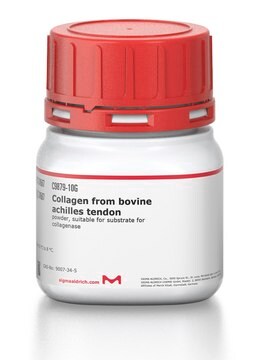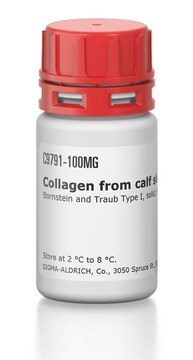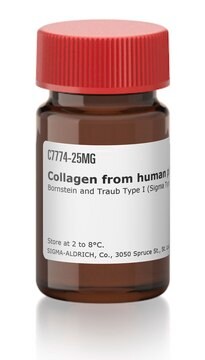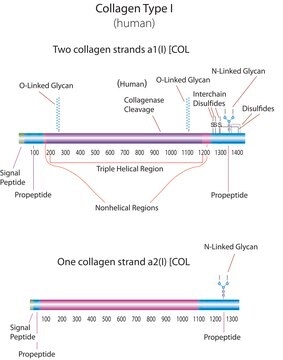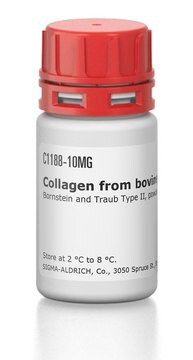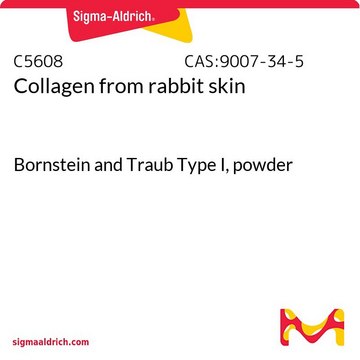おすすめの製品
product name
Collagen, from bovine flexor tendon
由来生物
bovine flexor tendon
無菌性
non-sterile
アッセイ
>96%
形状
lyophilized powder (fibrous)
包装
pkg of 1 g
テクニック
cell culture | mammalian: suitable
UniProtアクセッション番号
結合特異性
Peptide Source: Elastin
Peptide Source: Fibronectin
Peptide Source: Laminin
輸送温度
wet ice
保管温度
room temp
遺伝子情報
bovine ... COL2A1(407142)
詳細
This product is supplied as a lyophilized fibrous powder in a 1 gram package size. Bioburden and endotoxin levels are tested – this product is not considered sterile.
This collagen product is naturally cross-linked yielding a robust material for applications which require structure and strength. This product can be readily prepared into such forms as tissue scaffolds, foams, sponges, suspensions, coatings, putties, films and sheets but does not form hydrogels. Using typical cross-linking methods, this material can be tuned for optimal in vivo resorption. This collagen product is ideal for tissue engineering applications and uses with inorganic and biomaterials.
The product is provided in user-friendly packaging for use and storage. Avoid extended exposure to ambient environment since this material is hygroscopic.
This collagen product is naturally cross-linked yielding a robust material for applications which require structure and strength. This product can be readily prepared into such forms as tissue scaffolds, foams, sponges, suspensions, coatings, putties, films and sheets but does not form hydrogels. Using typical cross-linking methods, this material can be tuned for optimal in vivo resorption. This collagen product is ideal for tissue engineering applications and uses with inorganic and biomaterials.
The product is provided in user-friendly packaging for use and storage. Avoid extended exposure to ambient environment since this material is hygroscopic.
調製ノート
Type I bovine collagen, insoluble lyophilized fibrous powder, is extracted from bovine flexor tendon with the raw material sourced from closed/controlled herds of animals. This product is very difficult to dissolve, and after following the below protocol you will end up with a viscous solution.
Note: The following procedure is based on solubilization of 1 gram of collagen in 100 ml to initially prepare a 10 mg/ml collagen suspension. Smaller quantities and volumes may be used but the same ratios of collagen and solutions should be used.
1. Weigh out 1 gram of collagen fibrous powder.
2. Reconstitute 1 gram of collagen with 50 ml of cold purified water (50% of the final volume).
3. Stir the collagen with the water continuously mixing for a minimum of 15 minutes until the collagen is fully wetted and the suspension appears to be a semi-solution.
4. Add 50 ml of cold 0.02 M HCl to the collagen mixture and stir for a minimum of 10 minutes. This will yield a collagen concentration of 10 mg/ml with the suspension continuing to appear as a semi-solution.
5. Measure the pH - the mixture should have a pH of 2 to 3.
6. Using Waring stick blender or equivalent, homogenize the collagen mixture for a minimum of 15 minute at a high speed ensuring that the collagen is fully homogenized. Ensure that the temperature of mixture does exceed 24°C. Upon completion, there should be no visual solids in the viscous suspension. Air bubbles with be prevalent.
7. To remove air bubbles, stir the solution on a stir plate and pull a vacuum on the suspension. This will remove the air bubbles.
8. At this point if a collagen concentration of less than 10 mg/ml is desired, the collagen can be diluted with 0.01 M HCl.
Note: The following procedure is based on solubilization of 1 gram of collagen in 100 ml to initially prepare a 10 mg/ml collagen suspension. Smaller quantities and volumes may be used but the same ratios of collagen and solutions should be used.
1. Weigh out 1 gram of collagen fibrous powder.
2. Reconstitute 1 gram of collagen with 50 ml of cold purified water (50% of the final volume).
3. Stir the collagen with the water continuously mixing for a minimum of 15 minutes until the collagen is fully wetted and the suspension appears to be a semi-solution.
4. Add 50 ml of cold 0.02 M HCl to the collagen mixture and stir for a minimum of 10 minutes. This will yield a collagen concentration of 10 mg/ml with the suspension continuing to appear as a semi-solution.
5. Measure the pH - the mixture should have a pH of 2 to 3.
6. Using Waring stick blender or equivalent, homogenize the collagen mixture for a minimum of 15 minute at a high speed ensuring that the collagen is fully homogenized. Ensure that the temperature of mixture does exceed 24°C. Upon completion, there should be no visual solids in the viscous suspension. Air bubbles with be prevalent.
7. To remove air bubbles, stir the solution on a stir plate and pull a vacuum on the suspension. This will remove the air bubbles.
8. At this point if a collagen concentration of less than 10 mg/ml is desired, the collagen can be diluted with 0.01 M HCl.
その他情報
Simultaneously vacuum filter 12 samples for rapid analysis of retentate or filtrate. Numbered positions on the filter plate assure accurate sample tracking. Sealing stoppers maintain vacuum on unused sample cups. Accessory extension barrels increase sample volumes from 15 to 50 mL.
Applications
General Filtration of 15 to 50 mL Samples, Preparation for Scintillation Counting
XX2702550 1225 Sampling Manifold
Replacement Parts
YY2214257 Hand Knob
5162 Top Plate
XX2702509 Filter O-ring, silicone
5163 Support Plate
XX2702510 Support Screen, 25 mm, polypropylene
XX11000PP Ball Valve, glass-filled polypropylene
XX2504755 Tubing, 1/4 in. x 23 in., latex
Accessories
XX2702552 Chamber O-rings and Plug Set
XX2702555 Sample Cup Extension Barrel
XX6200006P Filter Forceps, blunt end, stainless steel
XX7100004 Tubing 3/16 in. I.D. x 140 cm, silicone
Applications
General Filtration of 15 to 50 mL Samples, Preparation for Scintillation Counting
XX2702550 1225 Sampling Manifold
Replacement Parts
YY2214257 Hand Knob
5162 Top Plate
XX2702509 Filter O-ring, silicone
5163 Support Plate
XX2702510 Support Screen, 25 mm, polypropylene
XX11000PP Ball Valve, glass-filled polypropylene
XX2504755 Tubing, 1/4 in. x 23 in., latex
Accessories
XX2702552 Chamber O-rings and Plug Set
XX2702555 Sample Cup Extension Barrel
XX6200006P Filter Forceps, blunt end, stainless steel
XX7100004 Tubing 3/16 in. I.D. x 140 cm, silicone
保管分類コード
11 - Combustible Solids
WGK
WGK 1
引火点(°F)
Not applicable
引火点(℃)
Not applicable
適用法令
試験研究用途を考慮した関連法令を主に挙げております。化学物質以外については、一部の情報のみ提供しています。 製品を安全かつ合法的に使用することは、使用者の義務です。最新情報により修正される場合があります。WEBの反映には時間を要することがあるため、適宜SDSをご参照ください。
Jan Code
5162-1G:
試験成績書(COA)
製品のロット番号・バッチ番号を入力して、試験成績書(COA) を検索できます。ロット番号・バッチ番号は、製品ラベルに「Lot」または「Batch」に続いて記載されています。
この製品を見ている人はこちらもチェック
Chiara Parravicini et al.
PloS one, 15(4), e0231483-e0231483 (2020-04-23)
The GPR17 receptor, expressed on oligodendroglial precursors (OPCs, the myelin producing cells), has emerged as an attractive target for a pro-myelinating strategy in multiple sclerosis (MS). However, the proof-of-concept that selective GPR17 ligands actually exert protective activity in vivo is
Sylvain Merel et al.
Food chemistry, 289, 259-268 (2019-04-09)
Ethoxyquin (EQ) is an additive present in fish feed and its fate in fish should be carefully characterized due to food safety concerns regarding this compound. Therefore, the objective of this work was to identify the transformation products (TPs) of
Yongjian Yue et al.
Journal of cellular biochemistry, 120(8), 12300-12310 (2019-02-28)
The disorders of hemostasis and coagulation were believed to be the main contributors to the pathogenesis of pulmonary thromboembolism (PTE), and platelets are the basic factors regulating hemostasis and coagulation and play important roles in the process of thrombosis. This
Amjad Alagha et al.
Journal of biomaterials science. Polymer edition, 31(13), 1689-1705 (2020-05-14)
This study aims to achieve the principles of tissue engineering using biopolymers to be applied in the field of vital endodontic treatment to stimulate stem cells and engineering and regeneration of dentin tissue. the polymer blend was loaded with the
Paola Bonsi et al.
EMBO molecular medicine, 11(1) (2018-12-16)
Dopamine D2 receptor signaling is central for striatal function and movement, while abnormal activity is associated with neurological disorders including the severe early-onset DYT1 dystonia. Nevertheless, the mechanisms that regulate D2 receptor signaling in health and disease remain poorly understood.
ライフサイエンス、有機合成、材料科学、クロマトグラフィー、分析など、あらゆる分野の研究に経験のあるメンバーがおります。.
製品に関するお問い合わせはこちら(テクニカルサービス)